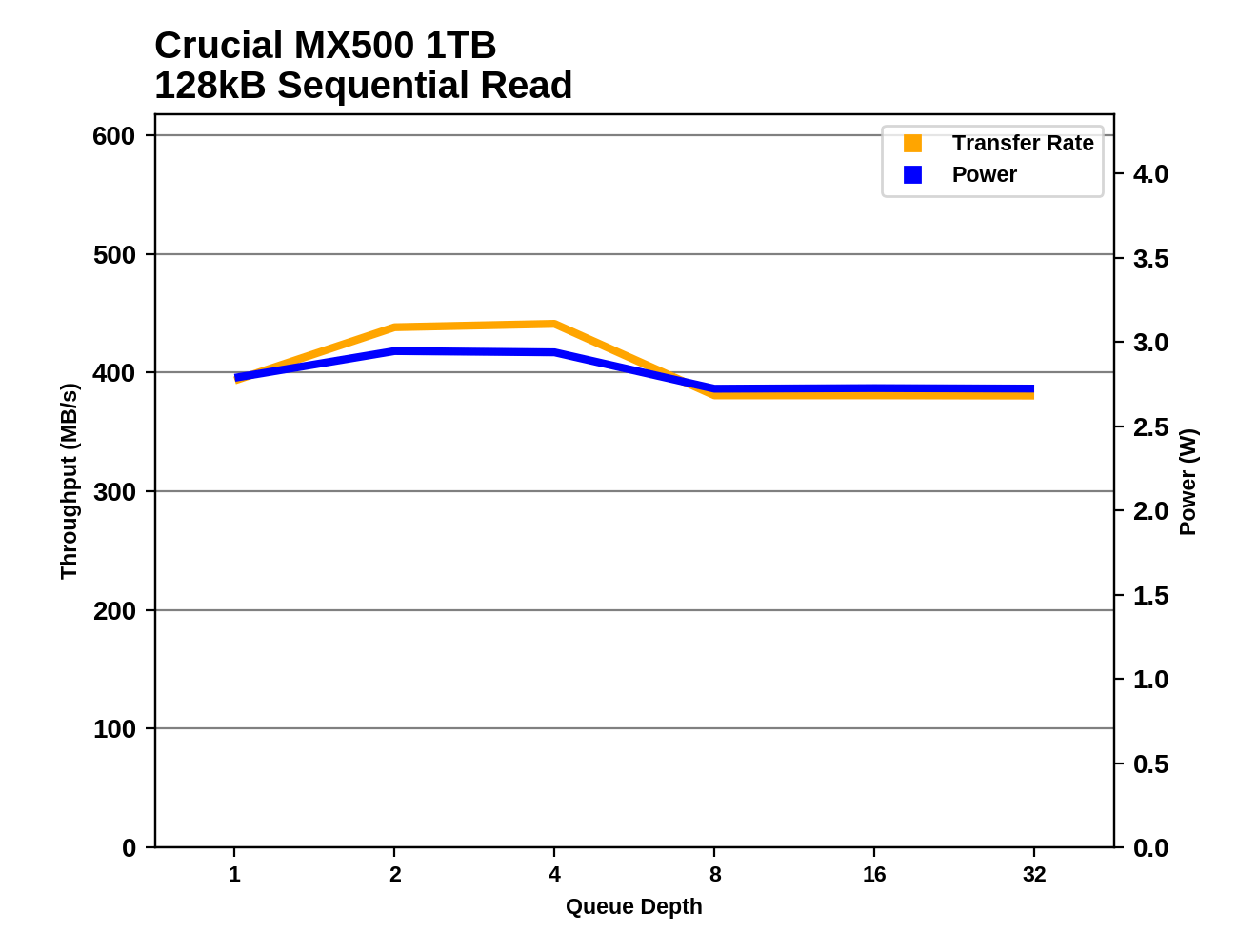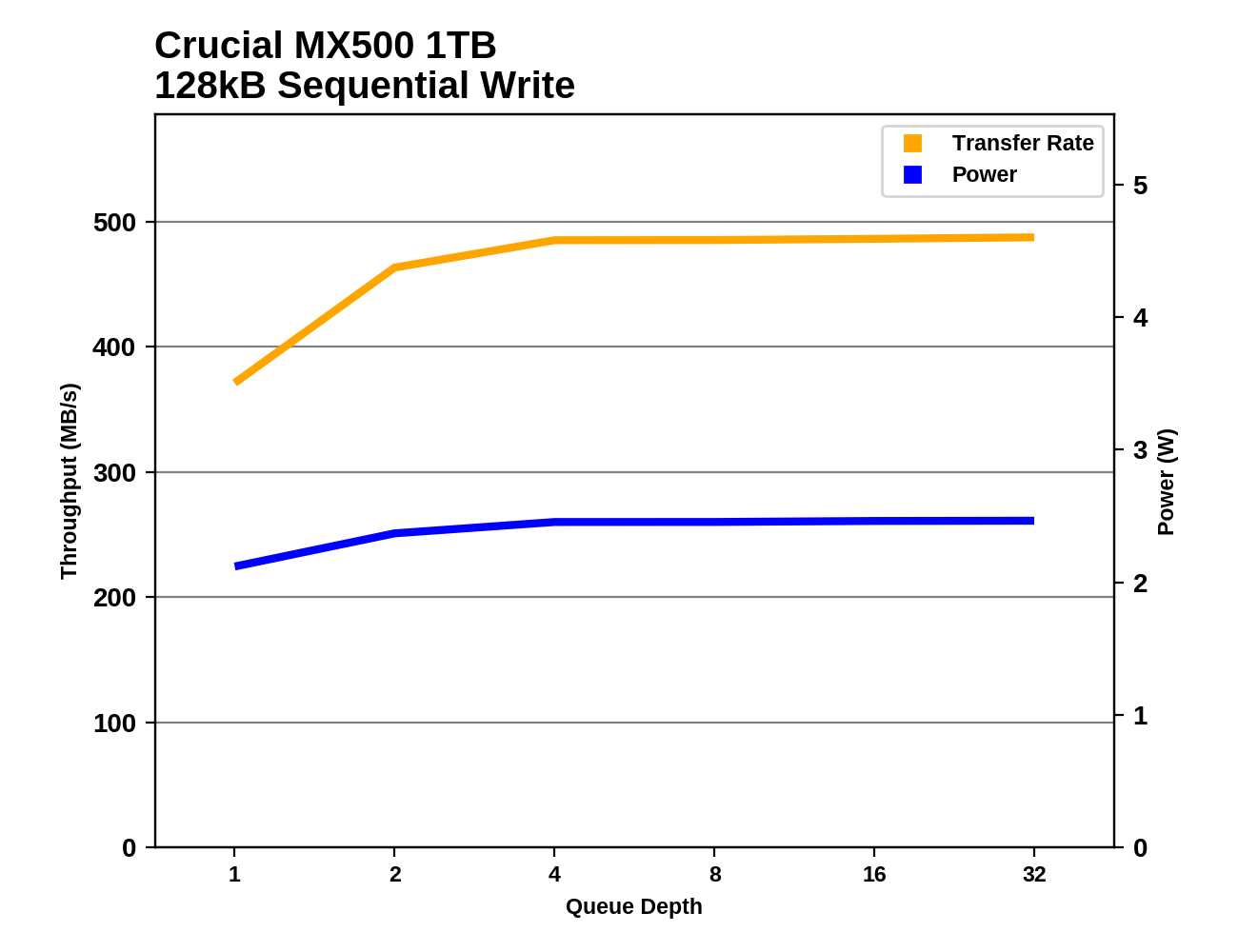The Crucial MX500 1TB SSD Review: Breaking The SATA Mold
by Billy Tallis on December 19, 2017 8:00 AM ESTSequential Read Performance
Our first test of sequential read performance uses short bursts of 128MB, issued as 128kB operations with no queuing. The test averages performance across eight bursts for a total of 1GB of data transferred from a drive containing 16GB of data. Between each burst the drive is given enough idle time to keep the overall duty cycle at 20%.

The Crucial MX500 turns in another record-setting burst performance score with its sequential read results, but by the smallest margin yet. It's about 6% faster on this test than most mainstream SATA SSDs.
Our test of sustained sequential reads uses queue depths from 1 to 32, with the performance and power scores computed as the average of QD1, QD2 and QD4. Each queue depth is tested for up to one minute or 32GB transferred, from a drive containing 64GB of data.

The sustained sequential read performance of the Crucial MX500 puts it in second place, behind the Samsung 850 PRO and 850 EVO. The MX500 does have a slight advantage over the other 64L 3D TLC drives, and improves on the MX300's performance by an impressive 100 MB/s.

The power efficiency of the Crucial MX500 during sequential reads is mediocre and clearly worse than the other 64L 3D TLC drives, including the Intel 545s. The MX500 is slightly more efficient than the Samsung 850 PRO and EVO, and scores 21% higher than the MX300.
 |
|||||||||
The Samsung 850 PRO and EVO are the only drives that continuously saturate the SATA bus from QD2 onwards with no drops in performance. The MX500's performance is reasonably steady but does drop a bit as the test wears on.
Sequential Write Performance
Our test of sequential write burst performance is structured identically to the sequential read burst performance test save for the direction of the data transfer. Each burst writes 128MB as 128kB operations issued at QD1, for a total of 1GB of data written to a drive containing 16GB of data.

For once, the burst performance of the Crucial MX500 doesn't set a record. Its QD1 sequential write speed is only second-fastest, about 3% slower than the Samsung 850 PRO.
Our test of sustained sequential writes is structured identically to our sustained sequential read test, save for the direction of the data transfers. Queue depths range from 1 to 32 and each queue depth is tested for up to one minute or 32GB, followed by up to one minute of idle time for the drive to cool off and perform garbage collection. The test is confined to a 64GB span of the drive.

The sustained sequential write speed of the MX500 is the same as the MX300, putting them in the second tier of performance behind the Samsung 850 PRO and EVO and the MLC-based Patriot Ignite.

The Crucial MX500 scores great on power efficiency during sequential writes, but not quite as well as the MX300. The OCZ VX500 with its reduced DRAM cache holds on to first place and the Toshiba TR200 (entirely DRAMless) comes in right behind the MX500. The mainstream 3D TLC drives are all much less efficient.
 |
|||||||||
Only a few drives offer a higher sustained sequential write speed than the MX500 after reaching saturation. The Samsung drives and the Patriot Ignite are faster at all queue depths and much less pwoer efficient than the MX500, while the OCZ VX500 stumbles at QD2 before saturating with slightly higher throughput and substantially lower power consumption. The MX300 is a bit faster than the MX500 at QD2 but slightly slower at higher queue depths.










90 Comments
View All Comments
ddrіver - Thursday, December 21, 2017 - link
@Arnulf, Europe is a civilized land.sonny73n - Wednesday, December 20, 2017 - link
You remind me of the path I crossed with Samsung customer service about my 840 Evo (2 months old then).Dear valued customer,
Please contact your seller (Newegg)....
We acknowledged the issue. Please wait for firmware update....
The worst of all is that all their customer service reps don't know shit but they insisted to guide me, a veteran in IT field, how to install an SSD in my laptop. After firmware update, BSOD still happened but less frequent. Best thing I did was throwing that sucker in the trash.
Forget Shamesung and their shameless fanboys. This MX500 is a good deal but I prefer the BX300 because of MLC over TLC.
Samus - Wednesday, December 20, 2017 - link
The BX300 is such an incredibly good drive. I've outfitted 20 office PC's with them since they were introduced, no problems whatsoever.ddrіver - Wednesday, December 20, 2017 - link
@sonny73n, I'll just repost this here: https://www.usenix.org/conference/fast16/technical...Short version: the difference between SLC and MLC is almost indistinguishable. Don't imagine that MLC vs. TLC will be a world of difference either. Not with new drives.
Samus - Wednesday, December 20, 2017 - link
I had one of the worst warranty experiences ever with the 840 EVO years ago. Haven't given Samsung money since. OCZ and Mushkin, and Crucial for that matter, all have advanced RMA options and very smooth exchange processes. Crucial offers data recovery starting at $200.Samsung doesn't even return initial emails and they lie through their teeth on the phone, if you can even get ahold of the right person after being in a transfer loop for 30 minutes.
Cooe - Wednesday, December 20, 2017 - link
Recently??? Lol try well over 3 years ago. The 850 EVO's been using Samsung's V-NAND (V = vertical, as in 3D) pretty much since it's inception. In fact, they have used 3 (iirc) different types of V-NAND (differing in layer density) so far through production. You need to get with the program lol. Micron's slapping the EVO upside the head here, and I say that as someone who's bought more EVO's then I can count.lilmoe - Wednesday, December 20, 2017 - link
They just need to lower their damn price, and they'd still be good to go. Their 850 series is tried and proven, with a much better warranty, which is a significant advantage over newly released SATA models.Just cut the 850 Pro's price in half already Samsung.... I don't mind if they even cut the 10 year warranty in half dammit.
bill.rookard - Tuesday, December 19, 2017 - link
Agreed. Performance is pretty decent for a change! And having the 1TB available at the 250$ price point is also pretty aggressive as I'm sure it'll come down a stitch more in the next month or two.Samus - Wednesday, December 20, 2017 - link
The M550, MX100, MX200 and MX300 have always been decent contenders to Samsung 830, 840, 850 and 860, often priced lower and in the same performance bracket. Support and reliability are excellent.Chaitanya - Tuesday, December 19, 2017 - link
surprising crucial decided to keep mx line on tlc nand while bx was upgraded to mlc nand.